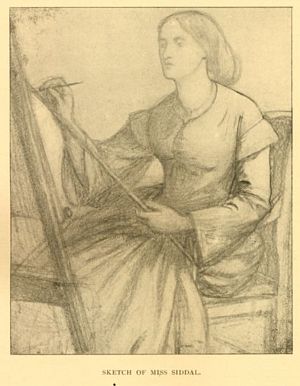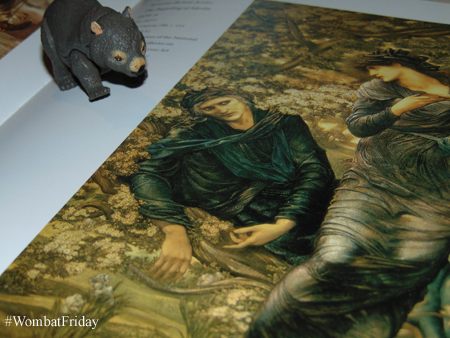I’ve spent my entire adult life pursuing Pre-Raphaelite art and in doing so, I find that what I actually discover is myself. Art and literature are crucial to my well-being, it provides a framework to draw upon when I need to process heavy emotion. If daily life intervenes and I allow my pursuit of art to fall to the wayside, then I feel a lack of balance that overwhelms me.
When I think about this need for intellectual stimulation, these words from The Once and Future King come to mind. “The best thing for being sad,” replied Merlin, beginning to puff and blow, “is to learn something. That’s the only thing that never fails. You may grow old and trembling in your anatomies, you may lie awake at night listening to the disorder of your veins, you may miss your only love, you may see the world about you devastated by evil lunatics, or know your honour trampled in the sewers of baser minds. There is only one thing for it then — to learn. Learn why the world wags and what wags it. That is the only thing which the mind can never exhaust, never alienate, never be tortured by, never fear or distrust, and never dream of regretting. Learning is the only thing for you. Look what a lot of things there are to learn.”–T.H. White, The Once and Future King
That’s an important book in the history of my life. I’ve had my copy since I was twelve or thirteen and it’s one of those books I could not bear to part with.
I discovered Pre-Raphaelite artist Elizabeth Siddal early in my adulthood and it was after the birth of my second child that my interest in her grew. I felt a strong urge to seek out her story, hungrily reading as much about her as I could. I didn’t make the connection at the time, but twenty years later I realize that there is a strange sort of parallel that it was during that time that my interest in her grew. Without meaning to, I was following Merlin’s advice. I’ve spent the past thirteen years writing about her on this site and at LizzieSiddal.com and whenever I have endured personal struggles, it has healed me. “Look what a lot of things there are to learn”, Merlin said and I think that’s one of the most hopeful sentences I have ever had the pleasure to read.

My son Donovan was born with Spina Bifida. His condition was not discovered during my pregnancy, so the news was a shock. My joy was quickly joined with fear and questions. My situation was vastly different than Elizabeth Siddal’s, who tragically birthed a stillborn daughter and then plunged into a cycle of grief and addiction, yet I do understand what it is like to be in the throes of a joyful pregnancy and then suddenly have to switch gears when the blessed event does not go as planned. It is jarring to the senses. Unable at first to process the news, it may appear to others that you are digesting the information when actually it’s all just sliding over you — sliding over the calm exterior you’ve put on simply because you don’t want to share the emotion with the people around you, don’t want them to know of the panic that has swelled so much inside of you that it seems hard even to breathe. The panic begins to feed your thoughts, thoughts that are now mainly interrogatives. How? Why? What does this mean? What do we do? When the panic subsides and you’ve answered the questions you can answer, your brain supplies new ones. Mainly of the “what next?” variety.
I don’t want to be presumptuous enough to say that I know Lizzie’s grief. I refuse even to associate the word grief with the birth of my son. I will say that since I was unaware during my pregnancy that he had Spina Bifida and that the hours after his birth were filled with shock and moments of denial and sadness, I have a sliver of understanding. Having a small glimpse into this unwanted world, I feel for Lizzie to a deeper degree. I was more fortunate than Lizzie, though. My son was not well, but he was alive. Lizzie’s feelings were permanent while mine were transient.
There was no hope for Lizzie’s situation to change while hope was all I had to cling to. I was able to sit by my son in the Neonatal Intensive Care Unit and stroke his little shoulder, the only area I could find unencumbered by wires, and whisper to him that no matter what, I felt that he was absolutely and breathtakingly perfect. Which was, and still is, the truth. I had a baby who needed me to be tenacious for him, to speak to doctors on his behalf, to gather all the information about Spina Bifida that I could find. I resolved to care for him in such a way that when he grew older he would know that there was nothing wrong with him, just differences.

I had him to absorb my focus and my love while Lizzie had an empty cradle to rock by the fireside, frantically telling visitors to hush so that they would not wake her lost child. Lizzie and other women of her era suffered through a time of misinformation and misunderstanding. Lizzie’s loss happened before grief was understood to be a process. Pain went untreated and was covered up. It was ages before people knew that with counseling and time, maybe things could get better.
It is no wonder that Lizzie sunk further into the grips of laudanum.
I’ve become acutely aware of how deeply important art is to my mental health and I am increasingly grateful that I have this website as an outlet to share that. I’ve explored grief through Isabella and the Pot of Basil. I’ve discussed the beauty of melancholy. I’ve shared about suicide and my thoughts on exploring death through art. All of these are heavy subjects, but I have also shared hope, music, and love. And wombats.
Art is a mirror. A healing mirror that elevates and sustains us. I cling to that. Art, music, books, movies. We must never stop being passionate in our pursuits.
“Look what a lot of things there are to learn. “



I have suffered from thoughts of Death for many years , the world weighs heavy with me; your blogs help me.
Andrew Dock
Thank you for sharing this with me. I hope you are able to find some solace.
Beautiful and useful post. Thank you.
Thank you.
Thank you for your poignant words, this is a thoughtful and enlightening post. Absorbing the beauty of art and making my own keep me strong and able to cope with my problems.
Thank you!
I don’t know whether God chooses people who are already sensitive and tenderhearted to bless with disabled children or whether the experience, itself, develops and nurtures those qualities in otherwise ordinary persons. I only know that my appreciation for beauty and my sensitivity for the needs of others has grown as my disabled son has grown. Most of all, I have a heightened awareness of the beauty and value of all life. I see in my son the same ‘absolute and breathtaking perfection’ that you see in Donovan. He is exactly as God intended him to be, and I am favored to be his protector and provider.
Thank you for this article it has evoked memories, dormant too long. It’s been a long time since I read this book so maybe I need to re-read it. Merlin said “The best thing for being sad is to learn something.”
I hope you are okay with me quoting you in this blog post. As I work with college students, I am always interested in having resources for them to turn to…that are not about buying things, but instead about seeking out the kind of support and solace and imaginative world that you talk about here.
I am definitely okay with that! Thank you!